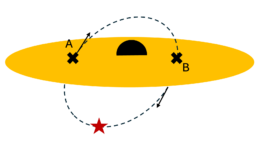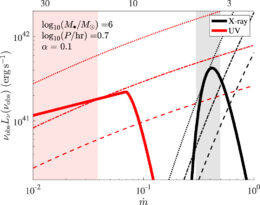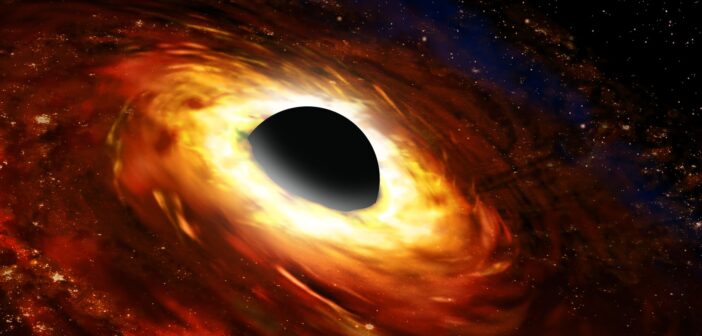Astronomers have discovered a handful of supermassive black holes that are associated with bursts of X-rays that recur every few hours or days. New work expands on a theory that explains these X-ray outbursts and explores how we can spot them at other wavelengths.
Investigating Quasi-periodic Eruptions
For the past few decades, researchers have seen X-ray flares coming from the centers of certain galaxies. These flares, dubbed quasi-periodic eruptions, last about an hour, and individual flares are separated by a few hours to a few days. The brightness changes from flare to flare, and the flares don’t recur at precise intervals, giving the events their name. The cause of quasi-periodic eruptions isn’t yet known, but leading models involve a star being partially torn apart by a supermassive black hole or an object interacting with gas accreting onto a black hole.

A simple diagram showing the proposed model. A star orbits a supermassive black hole on an orbit that is slightly elliptical (exaggerated here for clarity) and inclined relative to the accretion disk (yellow). The X’s mark the places where the star passes through the disk. The time between crossings at A and B is shorter than the time between crossings at B and A. [AAS Nova/Kerry Hensley]
An Ultraviolet Possibility
Now, Linial and Metzger have explored the implications of this model further, delving into the properties of quasi-periodic eruptions to understand if these events can only be observed at X-ray wavelengths, or if it’s possible to see them at other wavelengths as well. Because there are several planned and proposed ultraviolet survey missions, the team focused on the possibility of observing quasi-periodic eruptions in the ultraviolet. By outlining the equations that describe a star punching through a thin disk of gas around a supermassive black hole, the authors predicted how the brightness and timing of the flares depend on the size and mass of the star, how quickly the black hole is accreting gas from the disk, and other factors.

Luminosity of quasi-periodic eruptions as a function of accretion rate. This plot demonstrates how a system might transition from producing X-ray flares to ultraviolet flares, or vice versa, as the accretion rate changes. Click to enlarge. [Linial & Metzger 2024]
Citation
“Ultraviolet Quasiperiodic Eruptions from Star–Disk Collisions in Galactic Nuclei,” Itai Linial and Brian D. Metzger 2024 ApJL 963 L1. doi:10.3847/2041-8213/ad2464
